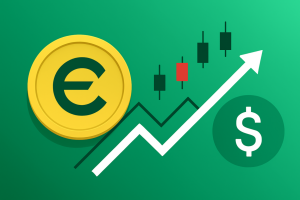BIC’s Video News Show: FTX Expansion

In this episode of the BeInCrypto video news show, host Jessica Walker gives an update on FTX. Both FTX and FTX.US have been in the news a lot lately for all the right reasons.
Back in July, the exchange raised nearly $1 billion in Series B funding. If it continues this rate of growth, it could overtake Coinbase in the US, or perhaps even Binance. We decided to take a closer look into FTX and its FTT token. So in this video we’ll discuss who’s behind the project, who’s investing in it, its NFT marketplace and its relationship with Solana.
Up in the charts
FTX’s push into the United States appears to be working, assisted by a rising interest in cryptocurrency trading. FTX’s campaigns aim to make it a name that even the most casual crypto fan will be familiar with. According to CEO Sam Bankman-Fried, the average daily volume of FTX reached new highs for the first half of 2021.
The FTX CEO attributes this growth to a massive marketing campaign along with the surge in the crypto market. Some estimates say that daily volume grew by more than 150x between June 2020 and June 2021. Trading volume peaked on April 22, 2021, with $993 million sent during a 24-hour period.
Additionally, according to Cryptowatch, FTX has the deepest liquidity of all US cryptocurrency exchanges. It has also secured a number of sponsorship agreements to grow even more within the country. Bankman-Fried’s other firm, Alameda Research, that deals in quantitative trading and manages over a billion dollars is proving to be a good choice as its digital currency provider.
Features galore
This success hasn’t been down to luck or simply riding the wave of crypto popularity. FTX has been building an ecosystem that covers all popular aspects of the crypto world. For instance, FTX Pay, which allows users to receive payments in both crypto and fiat currencies. They also have their own NFT marketplace, which launched recently. You can mint your own NFTs there, and it offers cross-chain trading between Ethereum and Solana. And this won’t be the last time we mention Solana in this video.
And they’re adding new stuff at a breakneck pace. The marketplace was announced several days ago, but there’s another big thing from the last 24 hours. FTX announced it will acquire LedgerX, a U.S.-licensed crypto derivatives exchange. If the deal goes through, it will pave the way for FTX.US to expand its offerings. It would also allow its American retail investors to access more derivative products.
Derivatives are tradable contracts that allow investors to bet on whether a price will increase or decrease, without actually owning the underlying asset. They are also hugely popular among those trading stocks and commodities. Traders can also use leverage provided by the exchange, but FTX has limited it to 20x.
Valuation
Back in July, FTX announced that it raised $900 million in a new funding round. This makes it the largest private equity fundraising in the shortest time in crypto history, and puts the company at a valuation of $18 billion.
FTX was valued at only $1.2 billion 12 months ago. Now it’s one of the world’s highest-valued crypto companies. The new valuation paves the path for its mainstream acceptance, particularly in American markets.
More than 60 investors participated in the funding round. Investors included Japanese giants SoftBank Group Corp. and Coinbase Ventures, with the latter definitely making an impression. It appears Coinbase is indirectly investing in a competitor.
Solana
Let’s talk about a couple of cryptocurrencies now, both of them strongly linked to FTX. First up is Solana, the coin in the spotlight right now, up from one dollar eighty on January 1st, to 200 this week. Even before the NFT marketplace we mentioned before, FTX and the Solana team had and still have a common project.
It’s a decentralized exchange called Serum, and it’s built on Solana’s blockchain. Sam Bankman-Fried selected it because it promised more scalability through Proof of History compared to Ethereum’s proof of work. Serum, which FTX unveiled back in 2020, saw its trading volumes reach $1 billion in April.
We’d wager there will be more overlaps between these two in the coming months and years, as partnerships will be key to scaling at speed.
FTT
The second coin is FTX’s own token, FTT. It’s the backbone of the FTX ecosystem and is actually ranked quite high on CoinMarketCap at #26.
FTT provides its holders an opportunity to earn trading fee discounts and over-the-counter rebates on the FTX exchange. Token holders can also use FTT as collateral for futures positions. Meanwhile, institutions that want to buy a white-label version of FTX’s OTC portal and futures exchange can do so by using FTT.
So the FTX network’s growth tends to directly correlate with FTT’s price performance. The relationship was visible in the recent rally, as the Bitcoin Futures Open Interest on the FTX exchange recovered to $2.96 billion on Monday. At its highest, the OI was $3.02 billion on April 13, 2021.
Disclaimer
All the information contained on our website is published in good faith and for general information purposes only. Any action the reader takes upon the information found on our website is strictly at their own risk.














